Highlights – the overview
After we leave Iles Chausey, we sail west to a bay near Saint Malo. We’ll spend a couple of days there before we move to the marina and have to drive to Portugal for Sher’s appointment with the immigration office. We have a lovely downwind sail with our beautiful gennaker and arrive in time to enjoy a beautiful sunset. The next day starts off foggy, but we do some laundry and hang it outside under our “sunbrellie” (sun shade) to dry.


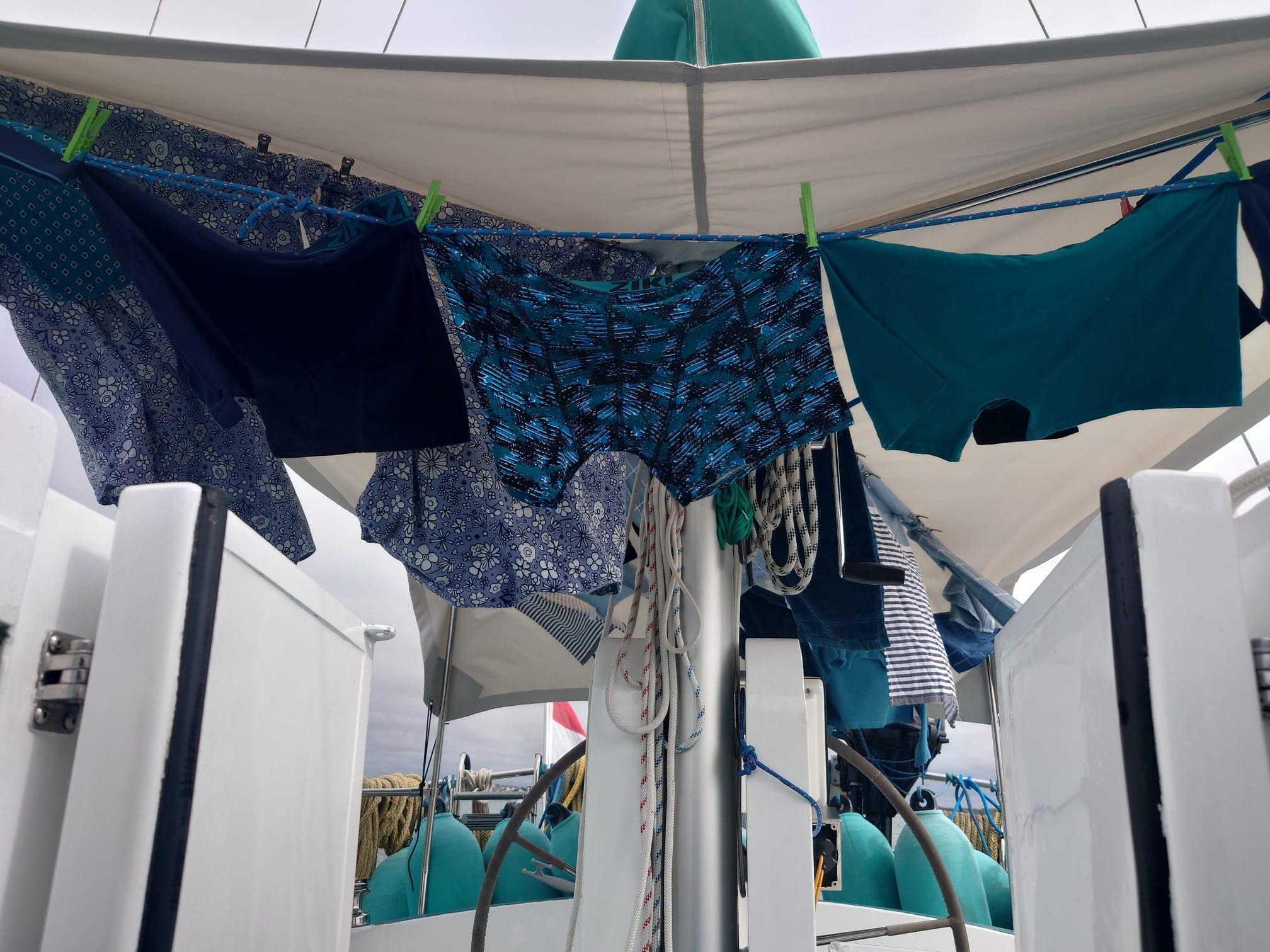
We wanted to clean the bottom, which entails “beaching” our girl. With a lifting keel, we can easily do that. Sher hasn’t experienced doing this before, but Wim and Dione-IV know how it goes. The anchorage we’re in isn’t suitable (we need a flat sandy beach), so we move around to another place that seems better. We anchor away from the beach and Wim goes to take a closer look with the dinghy. It looks great. When the tide is right, we’ll move closer in and dry out. While we wait for the tide, Wim does a a project… trying to figure out why our drinking-water pump is continually running. He finds a little particle stuck in the valve and installs a small filter so this won’t happen again.
When the tide is right, we move into position and let the tide continue to go out so we are on the beach. We woke a bit late and so we may not be completely dry, but at least we’ll be able to clean the waterline and some below it. We nose up to the beach until the bow gently kisses the bottom and put out the anchor in 1m of water. Wim uses a pressure cleaner and Sher stays on deck to feed the lines and cable. That works well, but doesn’t get everything, so Wim goes back with a scrub brush to get the little bits that are still stuck.
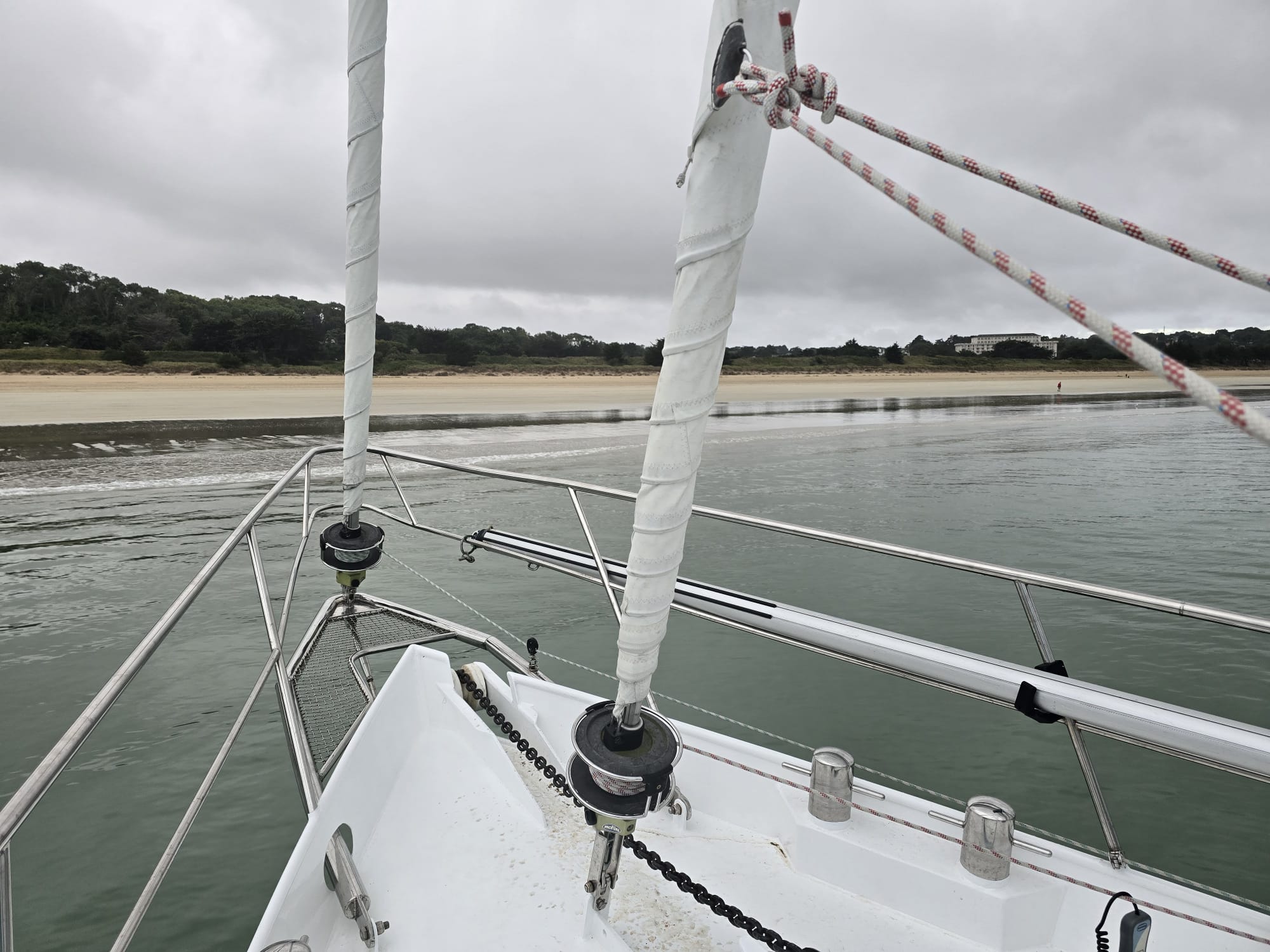
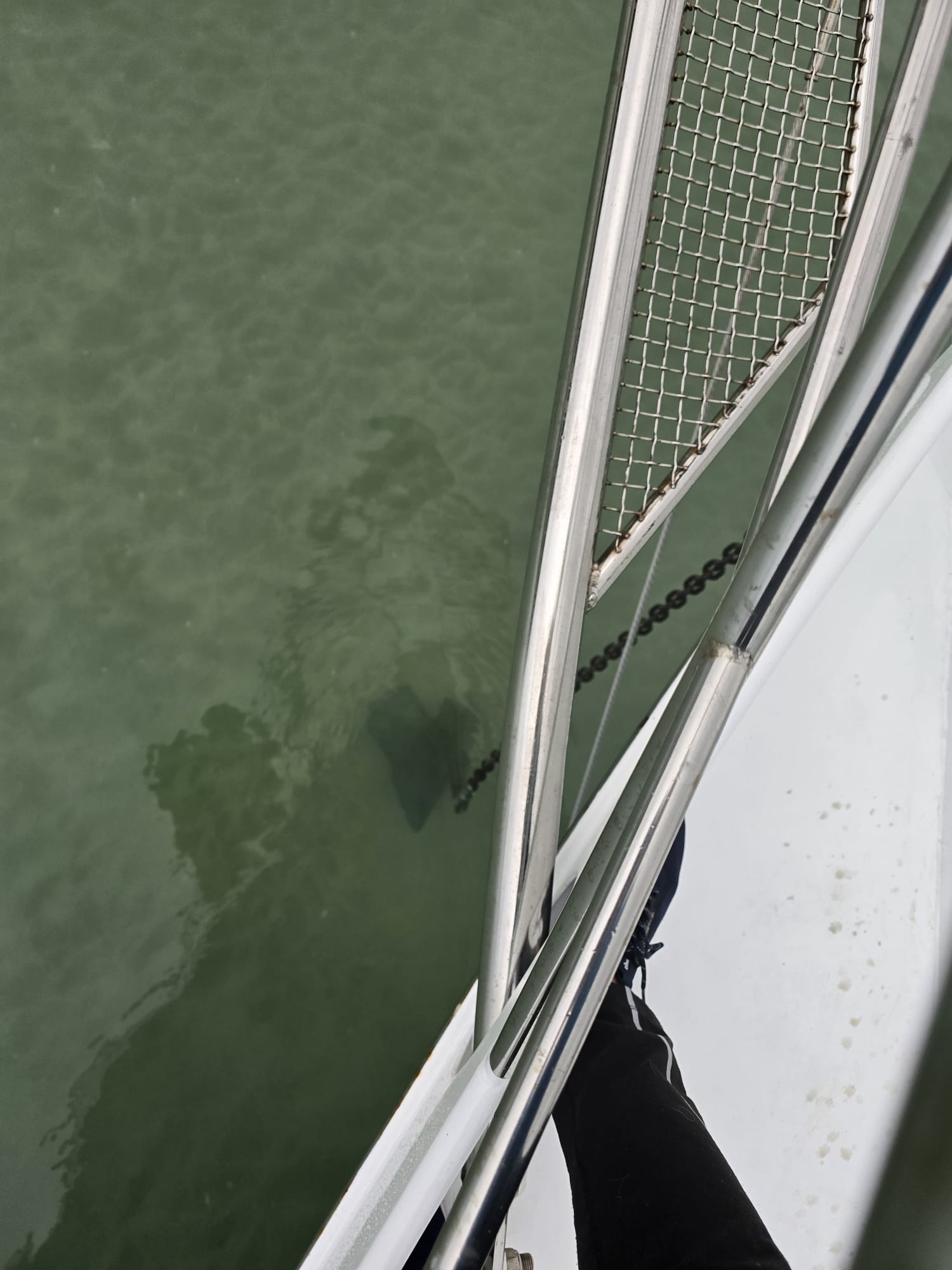
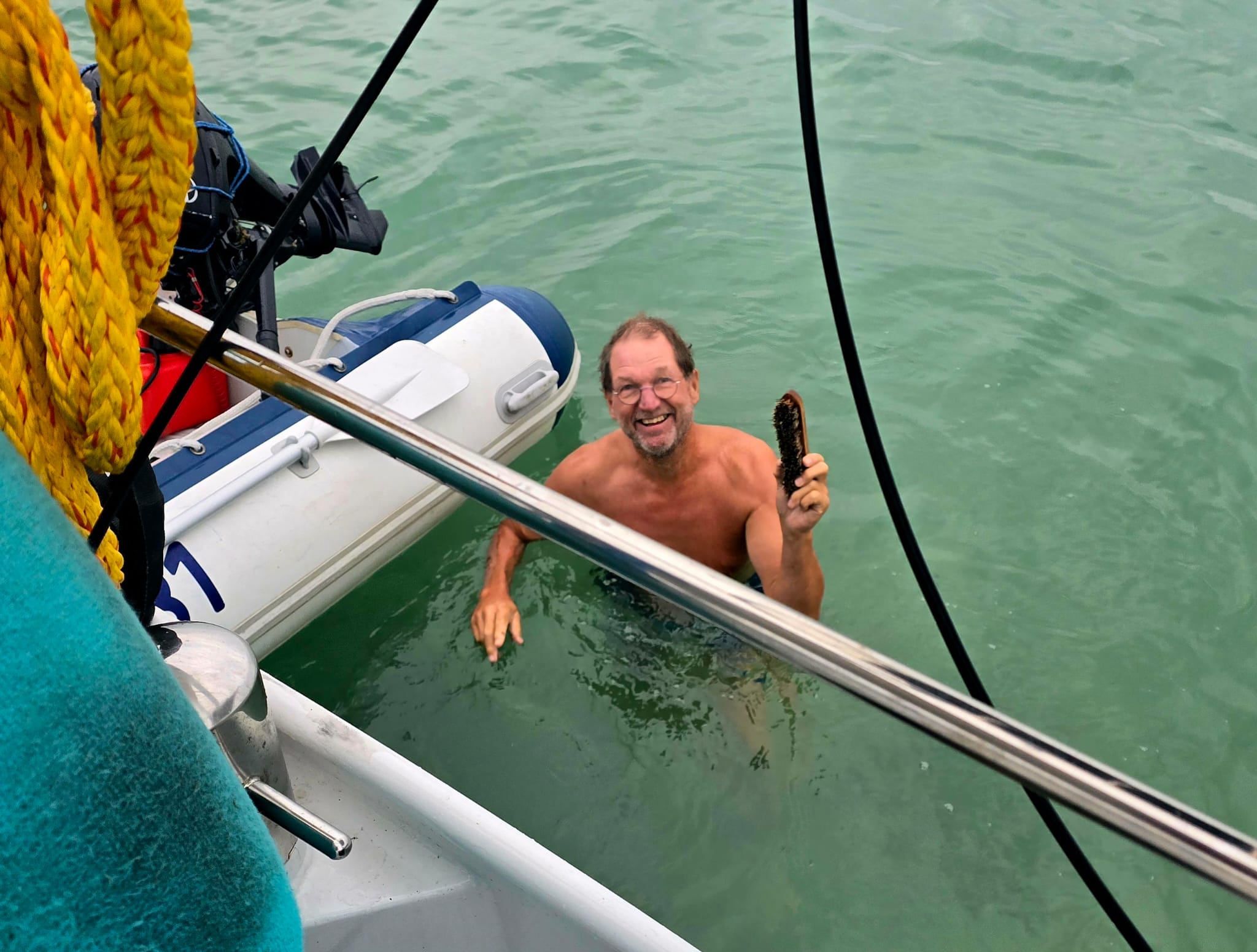
Slowly, the tide changes and the water rises. Wim has manually dragged the anchor 30m down into the sea, to be afloat sooner. But, hm… the wind changes direction and increases. The wind is now pushing us towards the shore and now it will take longer before we float again. Also, probably because the current reverses, a swell comes in. That makes us roll very heavily side to side. In one of these rolls, we pull up on the anchor chain hard with extreme force. And, because we are perpendicular to the anchor, the chain flips off the chain roller and hooks into the edge of our bow sprit damaging things. We put the snubber line on a bollard to reduce the force on the anchor chain so we can release it and put it back on the roller, but with the next swell and roll of the boat, that line breaks.
Meanwhile, on the inside, we hadn’t prepared for quite such a sideways roll and hadn’t locked the drawers and cabinets. One drawer came out with such force that the heavy items broke the front panel and everything came out. Luckily, thanks to the excellent-quality air-tight containers, we didn’t have a mess to clean up. All the containers stayed closed… otherwise, we would have been cleaning up coffee and flour and other bits and pieces! Finally, the water comes up enough that, with engine and bow thruster, we are afloat and on our way to Saint Malo!
There is a huge tide here (10-12m) so in order to get to the marina, we need to go through a lock. There are men to help with the lines… they throw a small line down to us and we fasten our line to it for them to pull back up and secure.
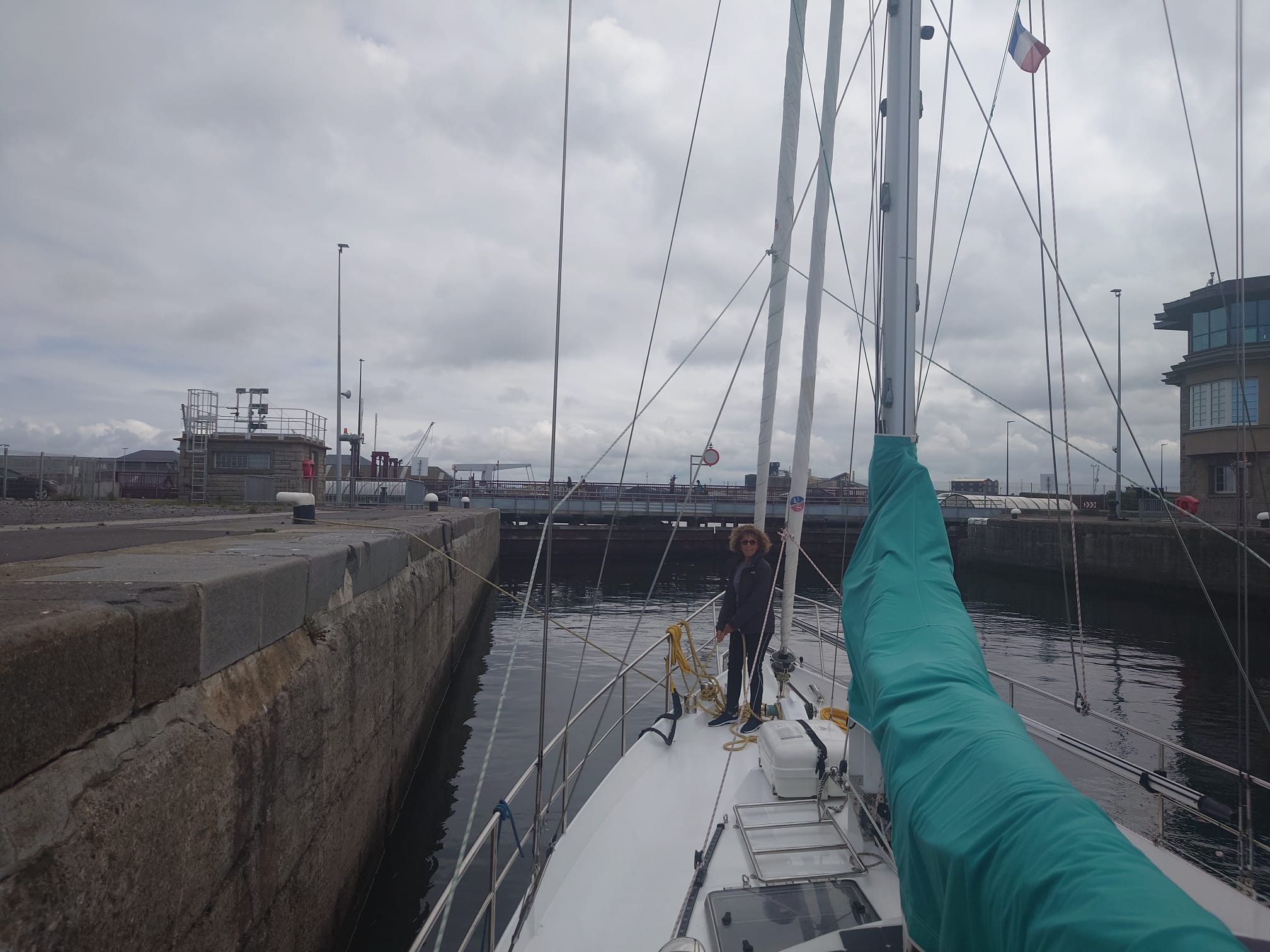
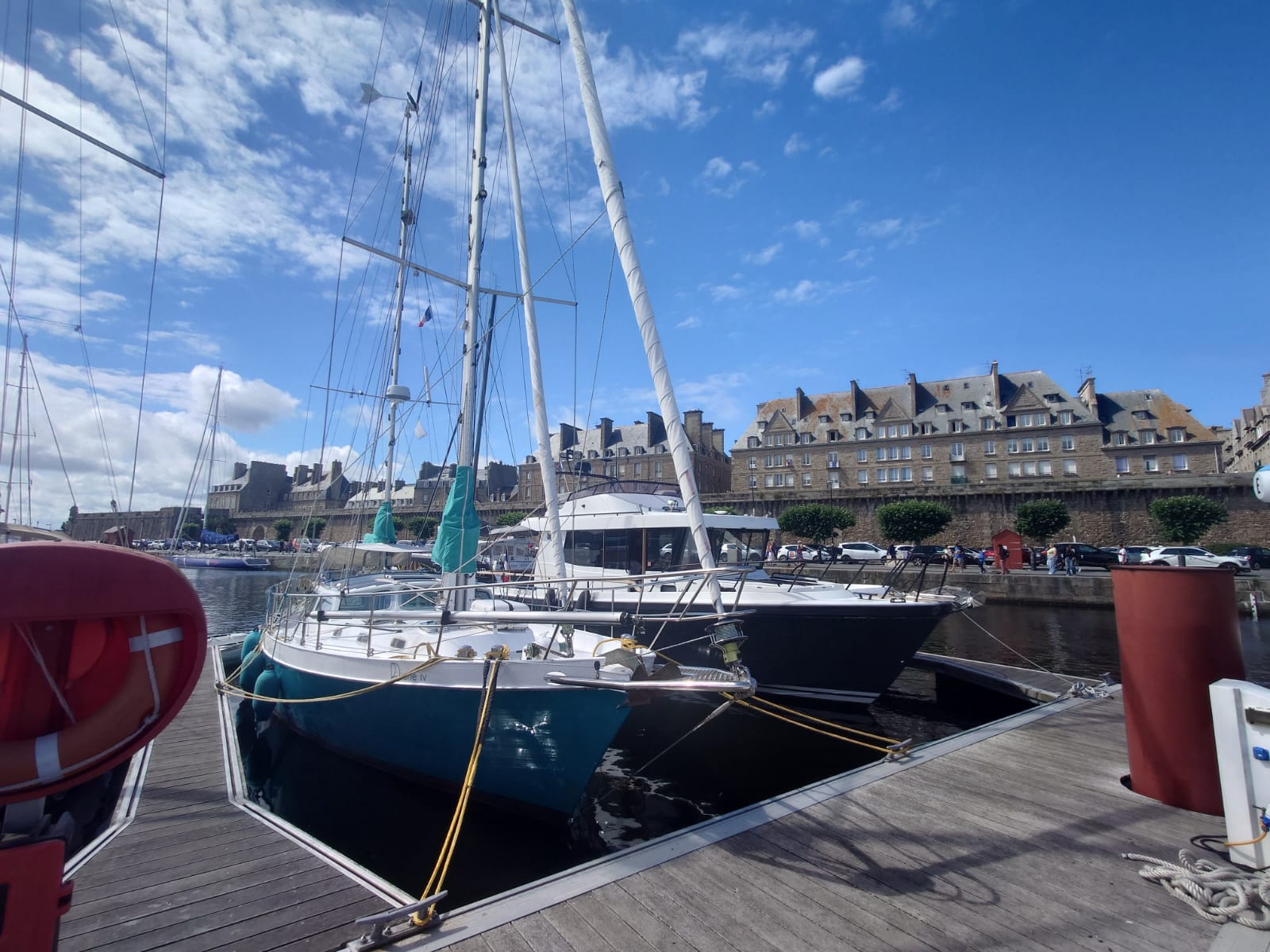
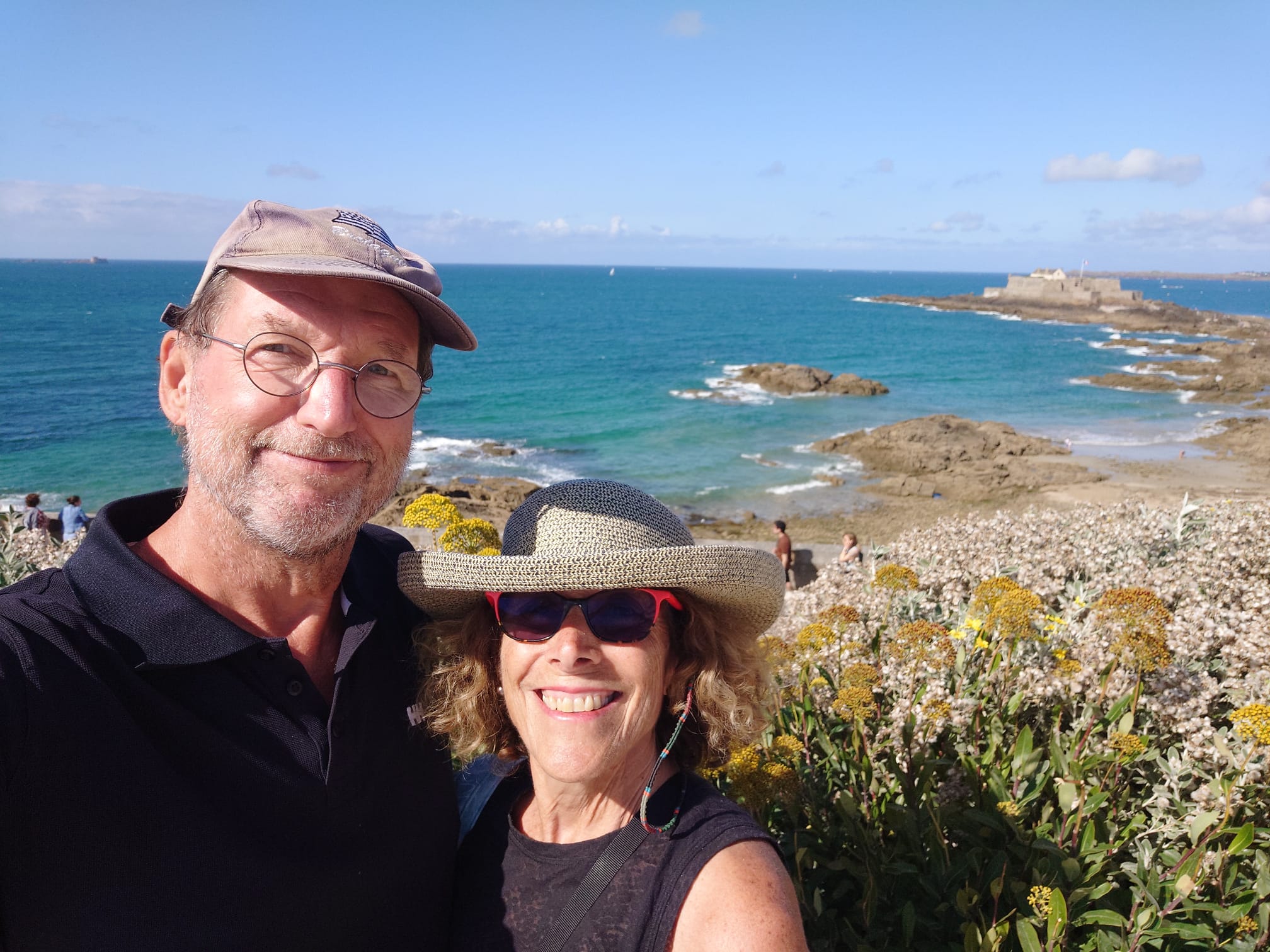
Once the water comes up we motor out, tie up in the marina, and secure the boat for a few days of inland travel! We still have the afternoon before we need to pick up the rental car, so we meander around the old town, a beautiful historic fortress city. It is packed with tourists! One day was enough of that and we are glad to be back on board!
The Captain’s Log (T+42, 43… 45) – the complete story
After we leave Iles Chausey by the end of the morning, we sail west to a bay near St. Malo. We’ll spend a couple of days there before we have to drive to Portugal for Sher’s appointment with the immigration office.
The wind is easterly so we have a nice downwind course. There is a light breeze (5-10 knots) so we hoist our beautiful gennaker.
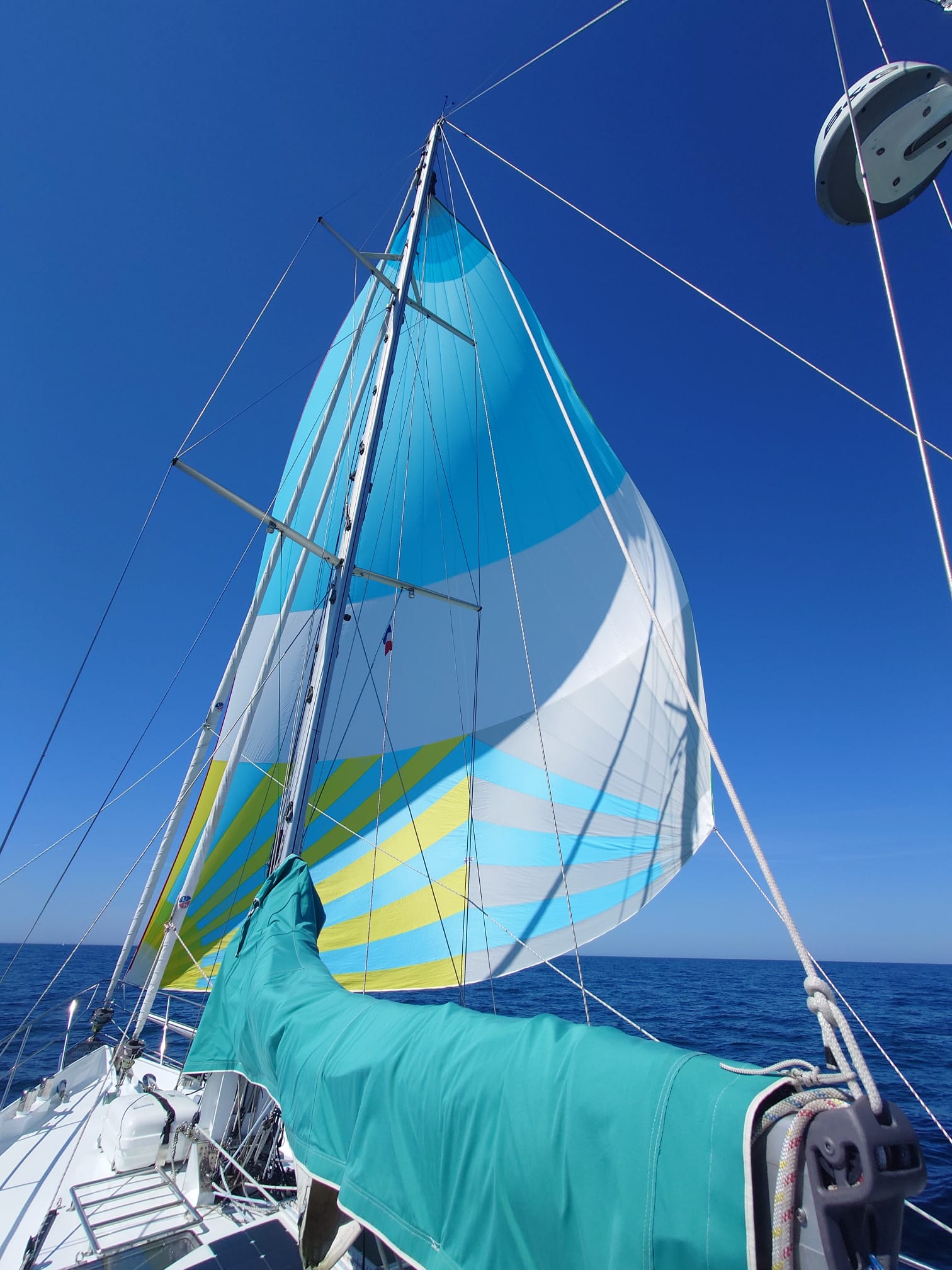

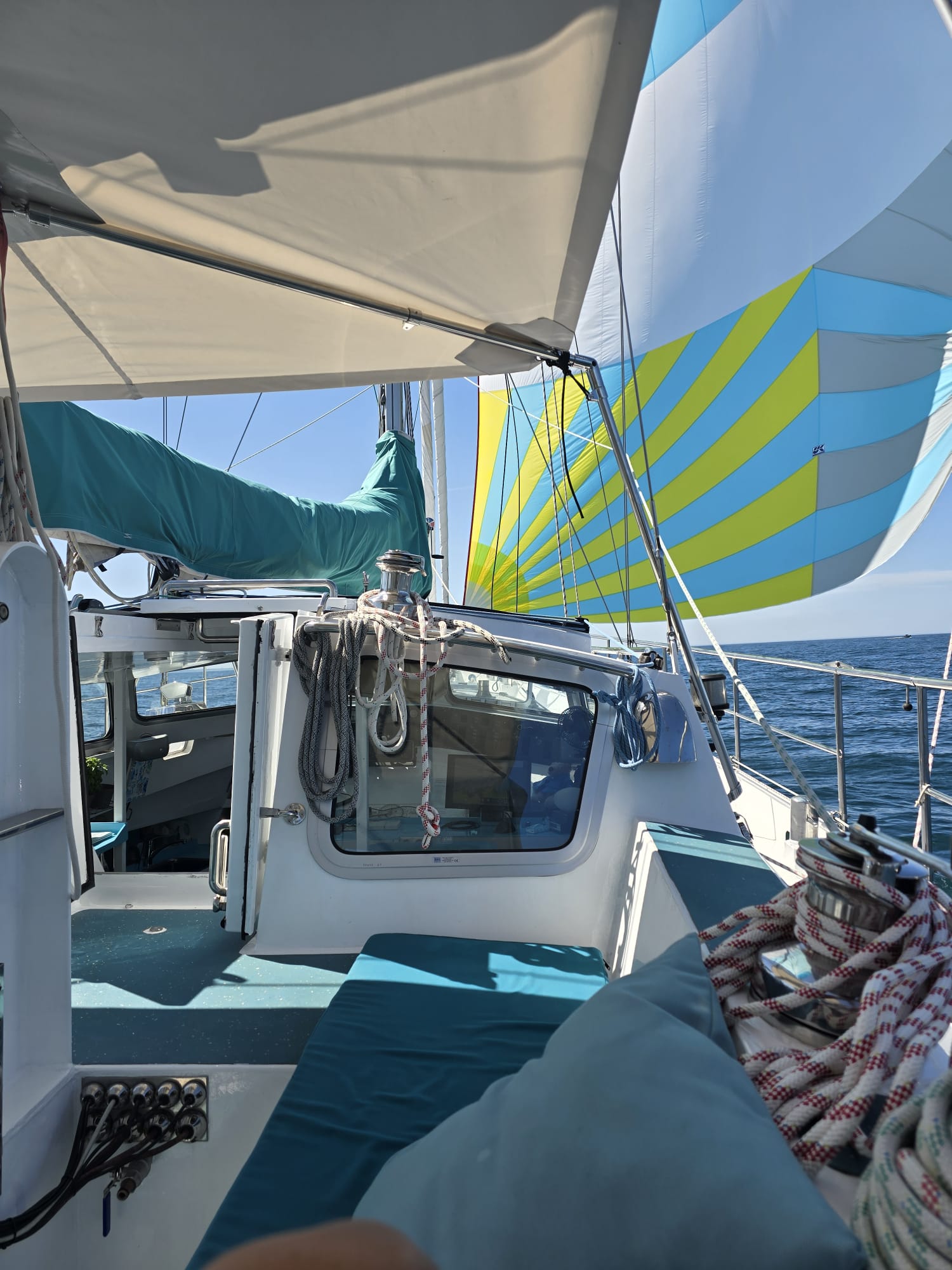
The first few hours, we have a light current (1 knots or so) against us and later in the afternoon we get that current with us. It’s a lovely warm day.
During the afternoon, the wind increases. We decide to take the gennaker down at 12 knots of wind. The sail can handle more wind than that but we’d like to see and feel how it is to take it down at 12 knots before we’re going to try it with more wind.
It goes well! The only difference with last time (when there was almost no wind) is that Sher has to release the sheet a bit more to deflate the sail, before Wim can pull the snuffer down. Next time to we’ll try 15 knots of wind!
At 18:30h we arrive at a little bay under the island “Ile des Hebihens”. It’s quite busy with lots of yachts anchored and all kind of water sports but we find a nice anchoring spot with good holding.
August 12 – Ile des Hebihens anchorage
That was a bit of a restless night. One of our anchoring neighbors had the weird habit of shining a very powerful flashlight at the boats around him, from time to time. Perhaps he was checking his anchor location or so? Anyway, he woke us up with these extremely bright flashes time after time. Idiots are everywhere….
When we wake up, it is foggy. The fog clears up after a few hours but it stays cloudy most of the day. We do some work on our computers, some small little jobs and some laundry.
There’s a lot sailing going on in this bay. Many small boat sailing classes circle us. It is a cheerful sight.

The laundry dries nicely under our sunshade! Although there is no rain today, it would stay dry here.
August 13 – Plage de Pen-Guen anchoring
In the early morning, we move to another bay a few miles west: Plage de Pen-Guen. Here’s a flat sandy beach and we will try to dry out here to clean our waterline. There’s some light weed at the waterline and 30cm’s beneath the waterline. Also, there are very small barnacles/pocks (about 5mm in diameter) in that same area. That grew when we were at anchor in the fresh water lake near Roelofarendsveen in the Netherlands and we expected it to die and disappear in salt water. But it didn’t.
We arrive at low tide so we can inspect the beach and decide where to dry out. We anchor close to the beach at 2.5m depth and Wim explores the area by dinghy. All hard, white sand, no rocks or boulders, nice and flat. This looks like a good spot for drying out provided that the weather stays calm. So, we’ll wait here for high tide and after that we’ll anchor closer to beach and dry out at the next low tide. That will be in the early evening.
It’s a lovely spot and we’re all alone here.
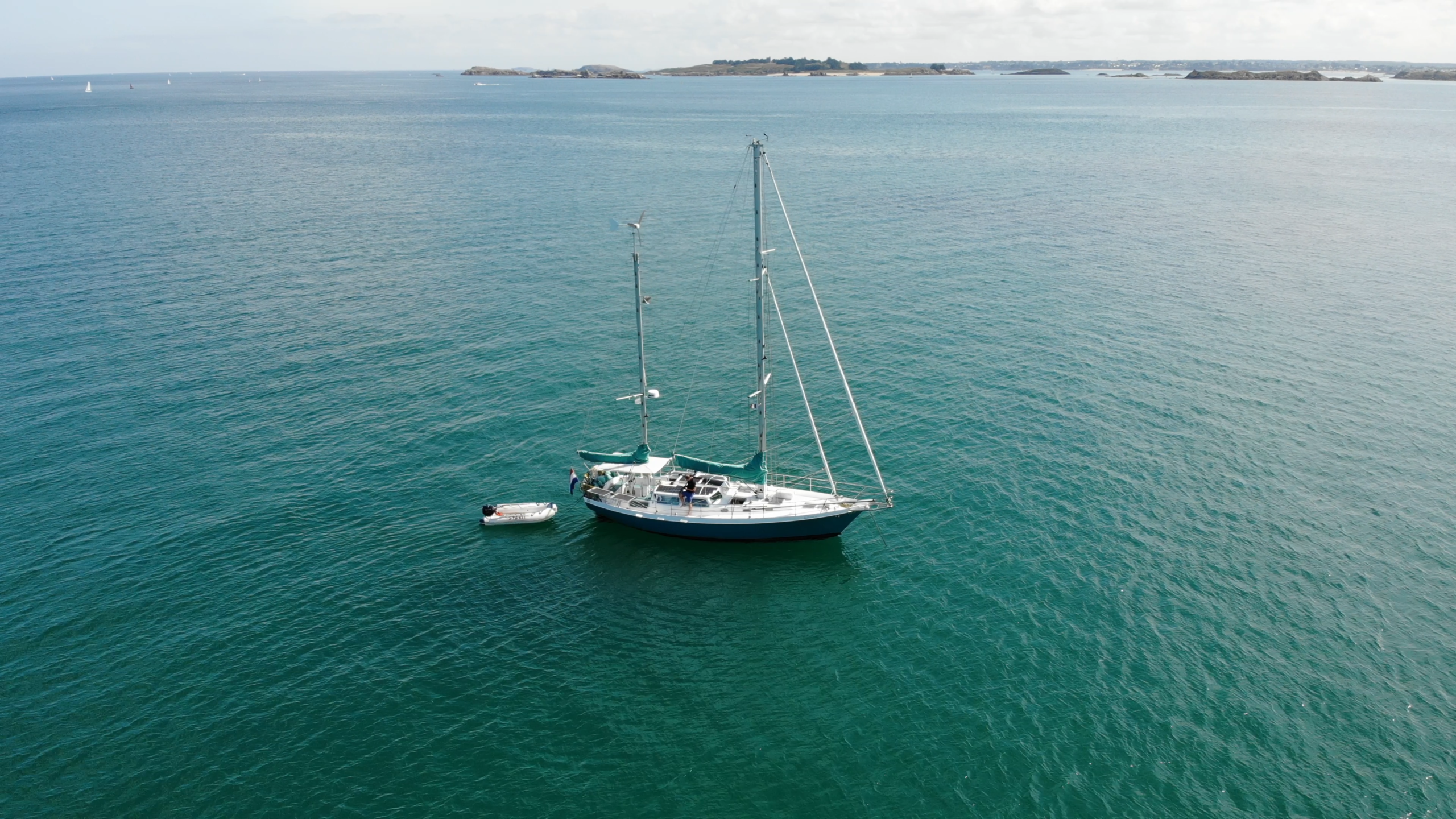
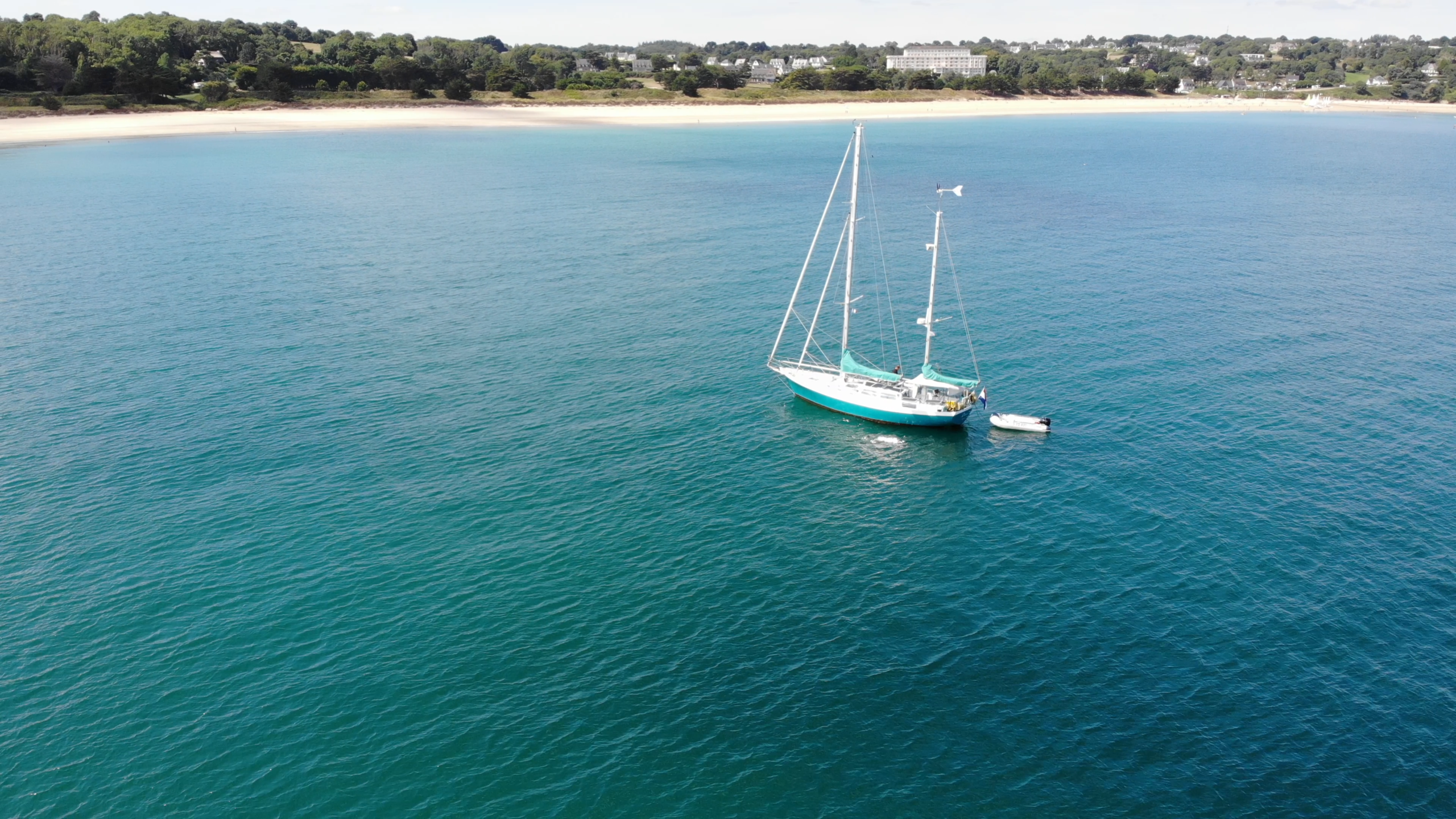
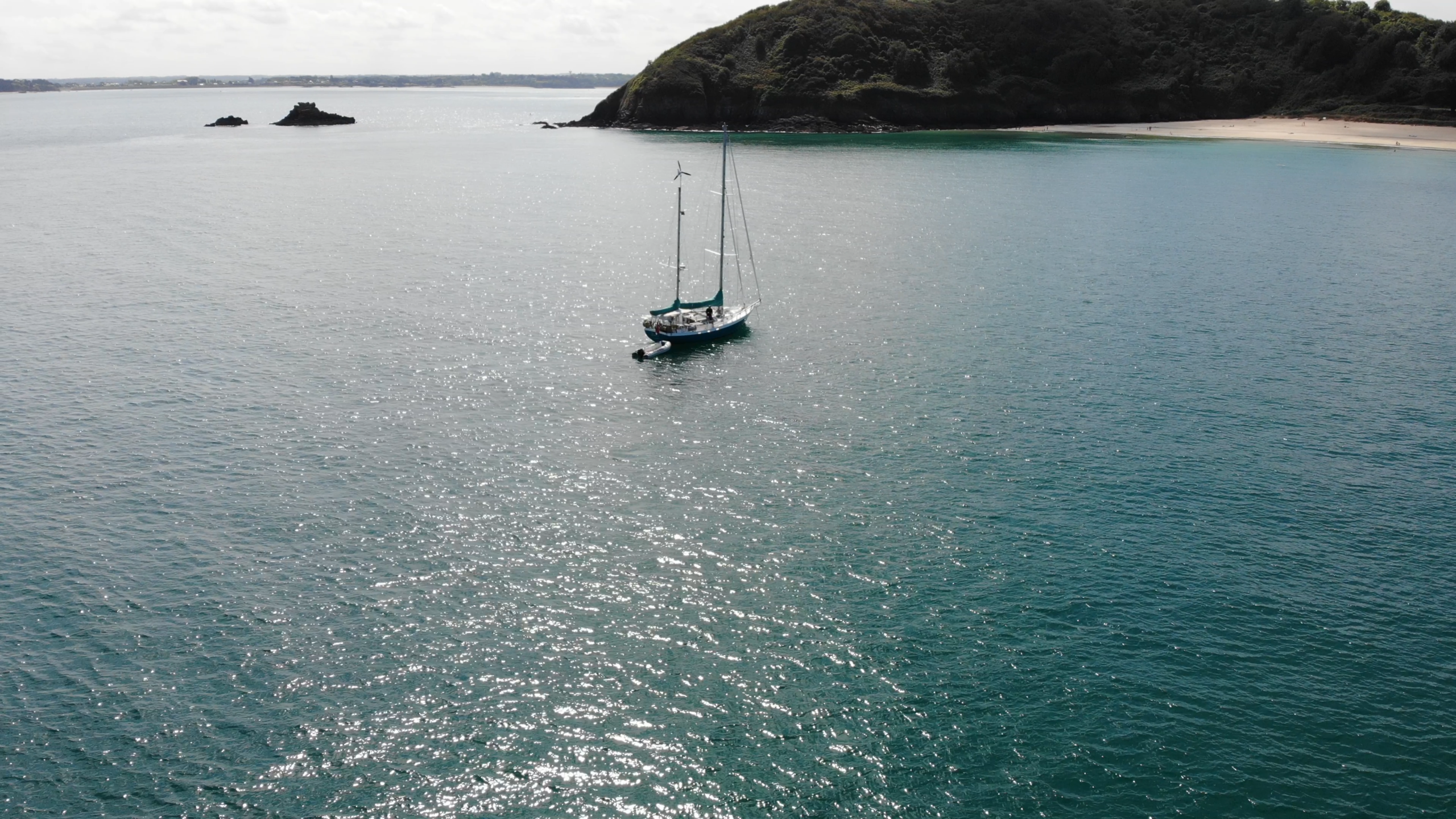
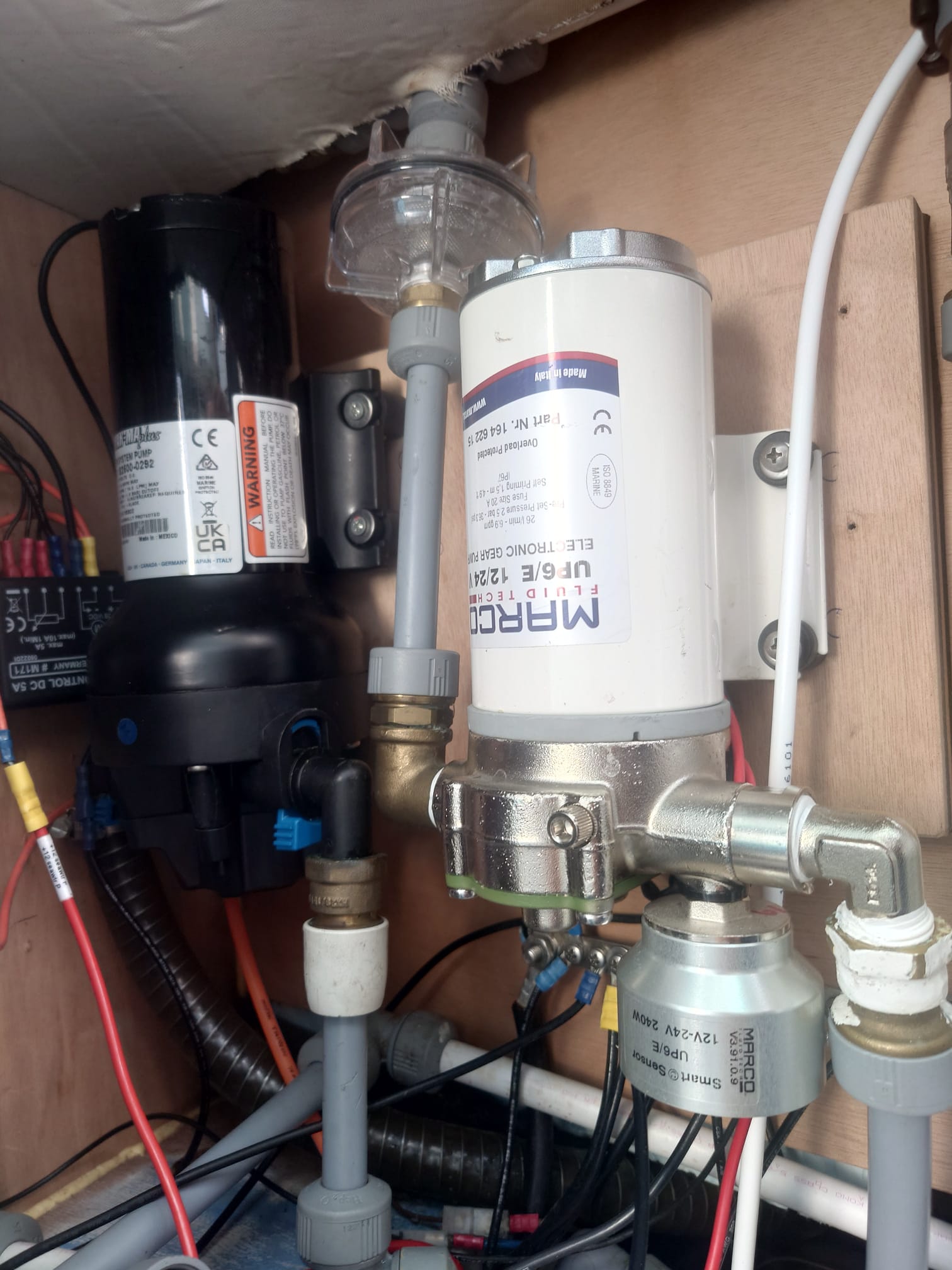
While waiting for the tide, we pick up a job at our drinking water pump. It has been running slowly while we didn’t use water the last few days. But we couldn’t discover anything leaking so the cause must be in the pump. We decide to take it apart and see if we can find anything.
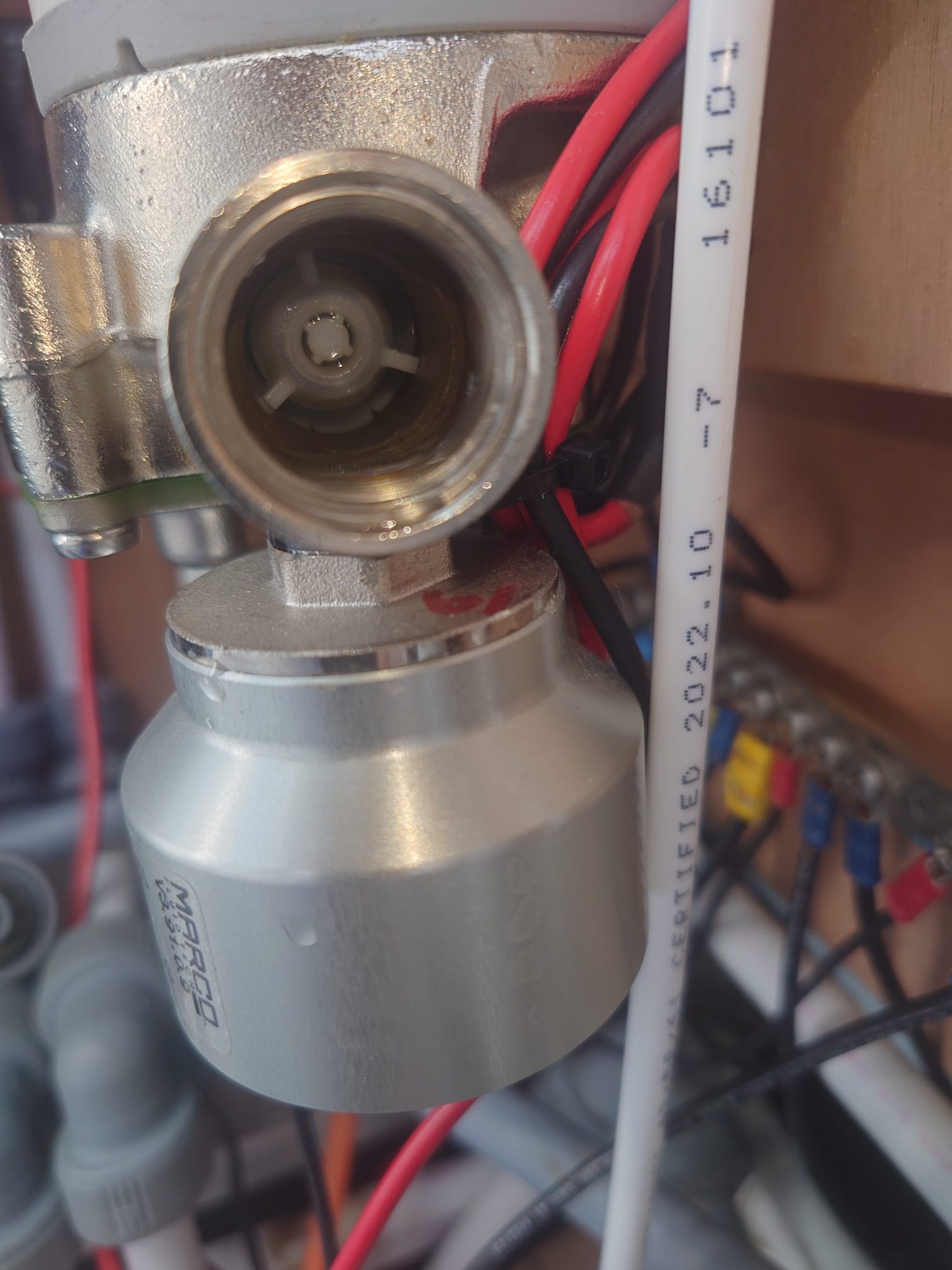
Aha, there’s a non-return valve in it and a tiny black plastic particle has stuck in the seat of the valve and blocks the valve from completely closing. After flushing it with water, the valve moves normally.

Probably, this plastic particle is a chip of the material the tank is made of. To prevent these kind of chips causing problems in the pump, we install a pre-filter.
That’s an advantage of having lots of materials on board! We had this pre-filter in one of our boxes with plumbing stuff 🙂
In the afternoon, the wind picks up and changes direction to the north-east. That causes waves in our direction. 3 hours before low tide we decide not to go drying out. The waves will make the boat bouncing on the hard sand bottom when she’s half afloat and we don’t want that. We decide to see what the situation is tomorrow morning, at the next low tide.
August 14 – beaching the boat and lessons learned
The wind has eased down completely yesterday evening and the situation is very calm as we wake up. We are a little late (one hour before low tide) but we decide to try it. We will at least have the waterline drying out to clean it.
We move up to the beach until Dione IV softly hits the sand. The very light breeze comes from the beach. Perfect.

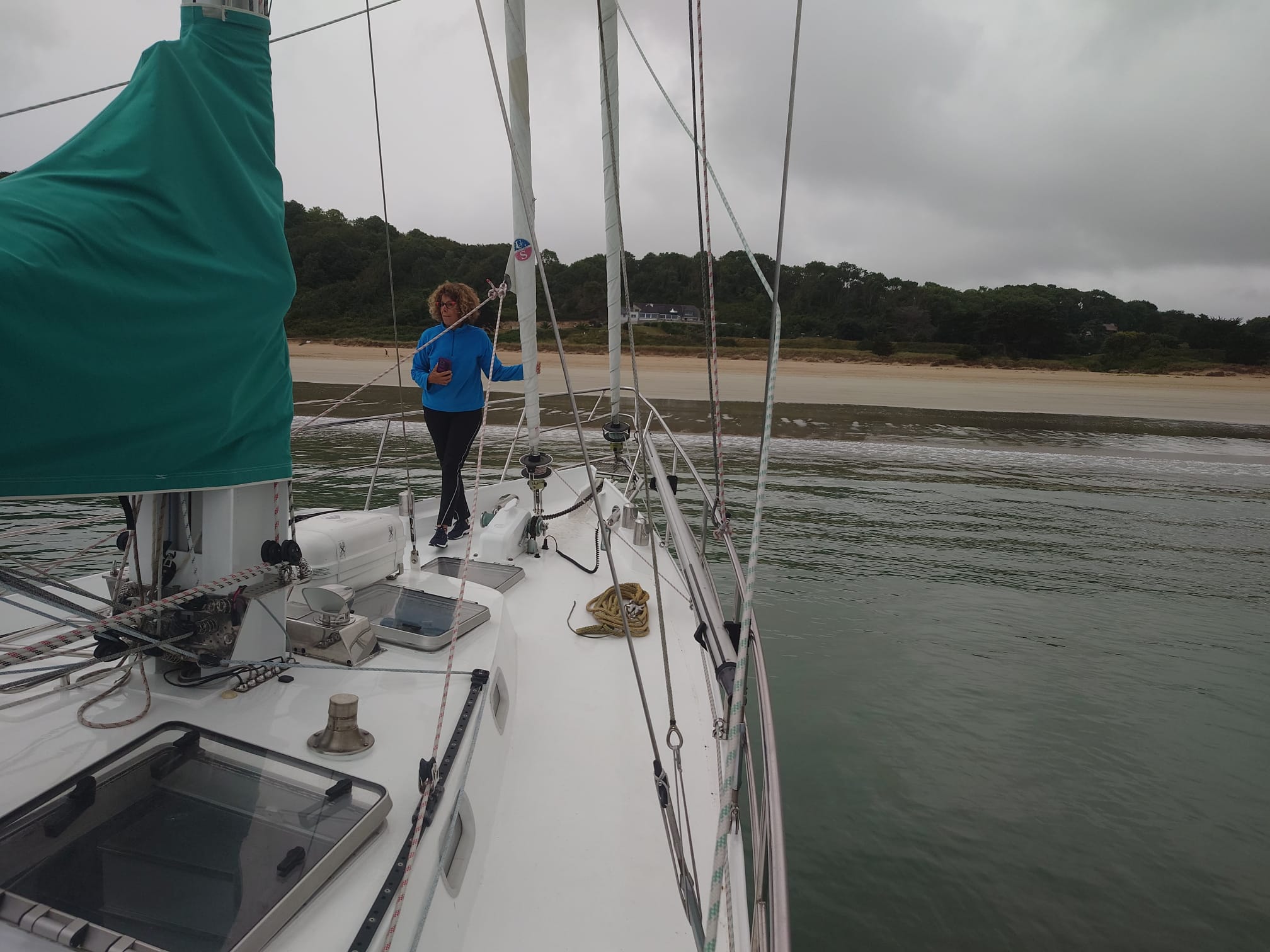


We wait till the water drops a bit and Wim steps overboard and starts cleaning the waterline. We have prepared our small high pressure cleaner and that works really well! The weed sprays off very easily. But the little pocks are a bit more difficult. Scrubbing these with the wooden back of the brush helps.
As said, we woke up a bit late. The water only drops down 10cm or so. So, we can clean the first 10cm of waterline with the high pressure cleaner. But with the brush, some of the underwater surface can be cleaned as well. But we’ll have to do this again later, when we can dry out more. Anyway, this was a good practice and it’s good to know that the little high-pressure cleaner works so well. Of course, it takes some water from our tanks and some electricity (1.6kW) but since we use it only very short, that’s no problem. Besides that, our plan is to go into the marina of St. Malo so we can fill up there. Anyway, our waterline looks a lot better now!
Slowly, the tide changes and the water rises. Wim has manually dragged the anchor 30m down into the sea, to be afloat sooner. But, hmm: the wind changes direction and increases. We are now at lee shore. Now, it will take longer before we float again. And, probably because the current reverses, swell comes in. That makes us roll very heavily. And in these rolls, we pull the anchor chain with extreme force. And because we are perpendicular to the anchor, the chain flips off the chain roller and hooks into the edge of our bow sprit, damaging things. We quickly attach the chain hook with the snubber and fix it to the front cleat/bollard. That releases the chain from its awkward position in the bow sprit. But because we roll so heavily on the swell, the forces on the anchor chain are enormous! One of the 2 lines of the snubber breaks when we roll over! These have a 5 tons breaking force! Wim quickly threads a new double line through the chain hook. In the next roll, the other line of the snubber breaks! Again, Wim threads another double line through the chain hook. That works.
In the meantime, Sher has to prevent things from shifting inside. A drawer wasn’t locked and has been opening with high speed and force, destroying the front panel and all plastic containers are spread out over the floor. Luckily, they are good quality air tight containers and they stay closed! Otherwise, we would have had a lot of stuff like flower and sugar and coffee all over the floor!
We have to wait till the water rises far enough to be afloat and sail away from here. Until that time, we heavily roll and bounce on the sea floor but we can do nothing but wait. Good that our anchor holds! The forces on the anchor must be huge. Perhaps even 10 tons or more, given the fact that the 5 tons lines broke so easily…
Well, after 15 minutes we turn straight behind our anchor and into the wind. So, we are afloat. We start the engine, pull up the anchor and sail away. Pfieuwww…. That was an unexpected and nasty situation. But we managed it well. Clever and safe. And we learned some lessons (notes to self!):
- Next time, dry out in a better sheltered area.
- With more stable weather. The weather was calm but there was a forecast for that wind for the afternoon. That came earlier.
- Our ground tackle has been tested. We already knew that our Delta anchor holds well but this time, we discovered that it holds like a rock!
- We have to make a heavy stainless-steel guide to prevent the chain from jumping off the roller.
- We could have lost our chain hook. But we have 3 spare hooks, one of them with pre-installed snubber lines.
- We could have lost our anchor if the chain or the swivel had broken. But we have a spare anchor under the couch in the salon and a spare swivel.
- We’re going to add big rubber snubbers in the lines to the chain hook. That would have dampened the extreme yanks better and perhaps the lines wouldn’t have been broken.
- Secure everything in the interior even though we didn’t expect heavy movements. We have a drawer to repair…
A little bit shaky after this adventure, we decide to do an easy sail to St. Malo. A half reach course with 10knots of wind on the yankee sail only.
Around noon, we arrive in the outer marina of St. Malo. We call them on the VHF but they have no berth for us. Everything has been reserved for a regatta. They advise us to go through the lock into the inside marina (Bassin Vauban).
Because the tidal difference is huge here (11 meters) and the lock only operates from 3h before high tide to 3h after high tide and we’re right at 3h before now, the step is pretty big: 6 meters. We have to wait a little and then the door opens. We sail into the huge lock but there are no places in the walls (as there usually is) to attach our lines?? There are 2 men on the other side and Sher asks: how are we going to do this? He gestures: climb the ladder! What? That dirty and slippery ladder in the wall, full of sea weed? About 8 meters up? Hmm.
As we start maneuvering to one of the ladders, we see at the other side that the men let down guide lines and hoist the lines from other yachts and attach ‘m to big bollards at the shore. Ah! So we have to go to the Port side… Unspool our 20m lines and yes, they are hoisted up!
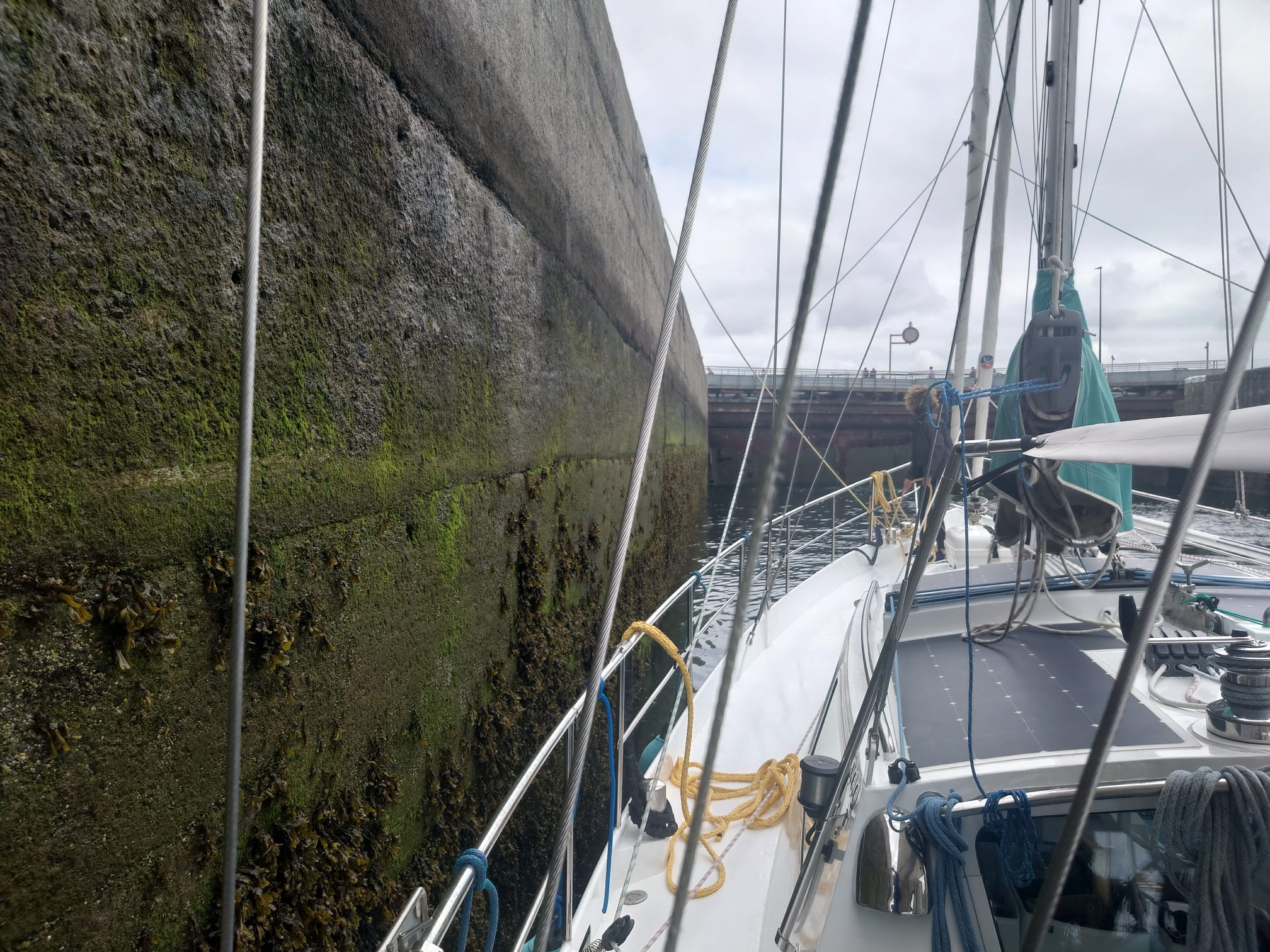
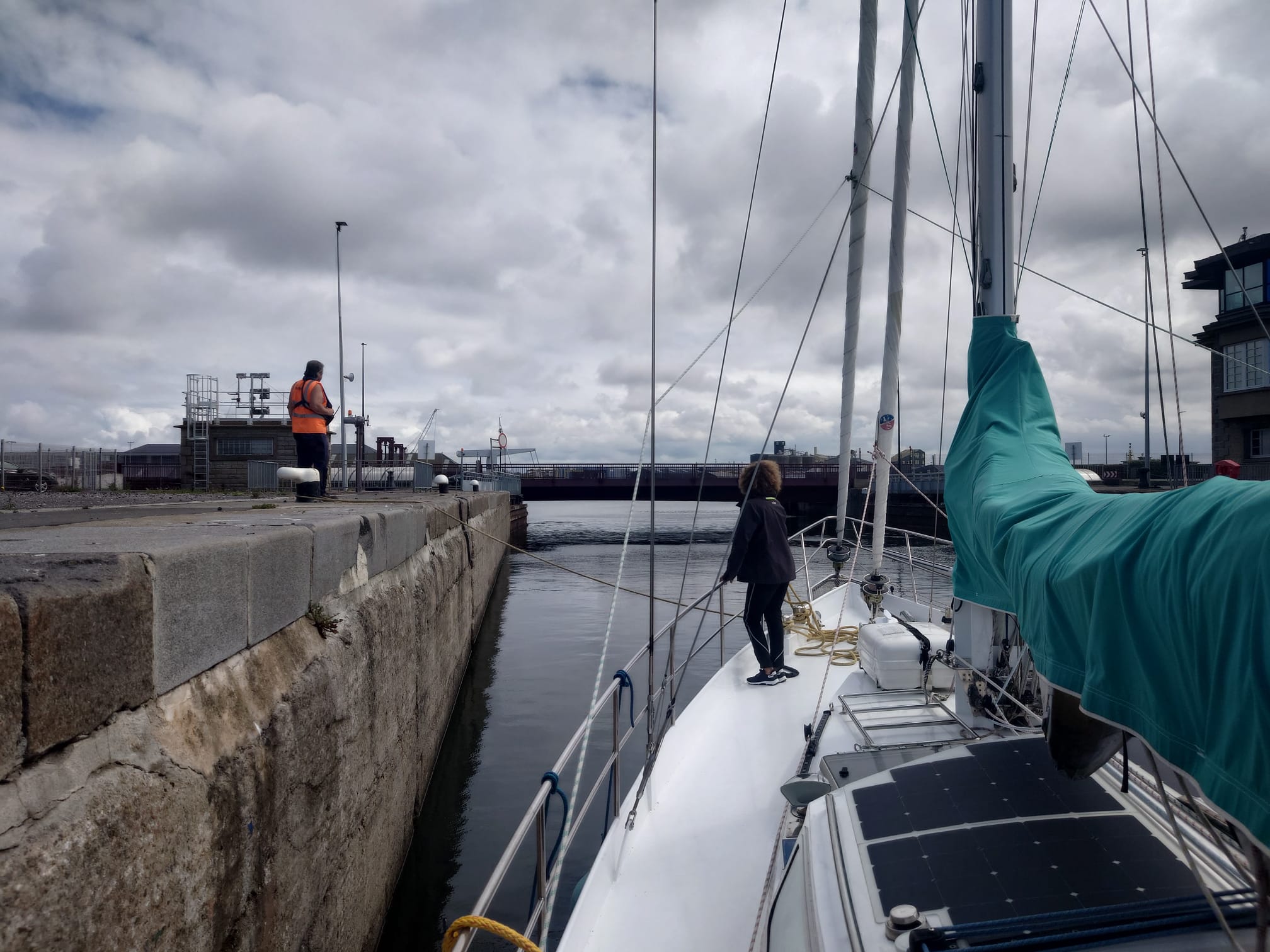
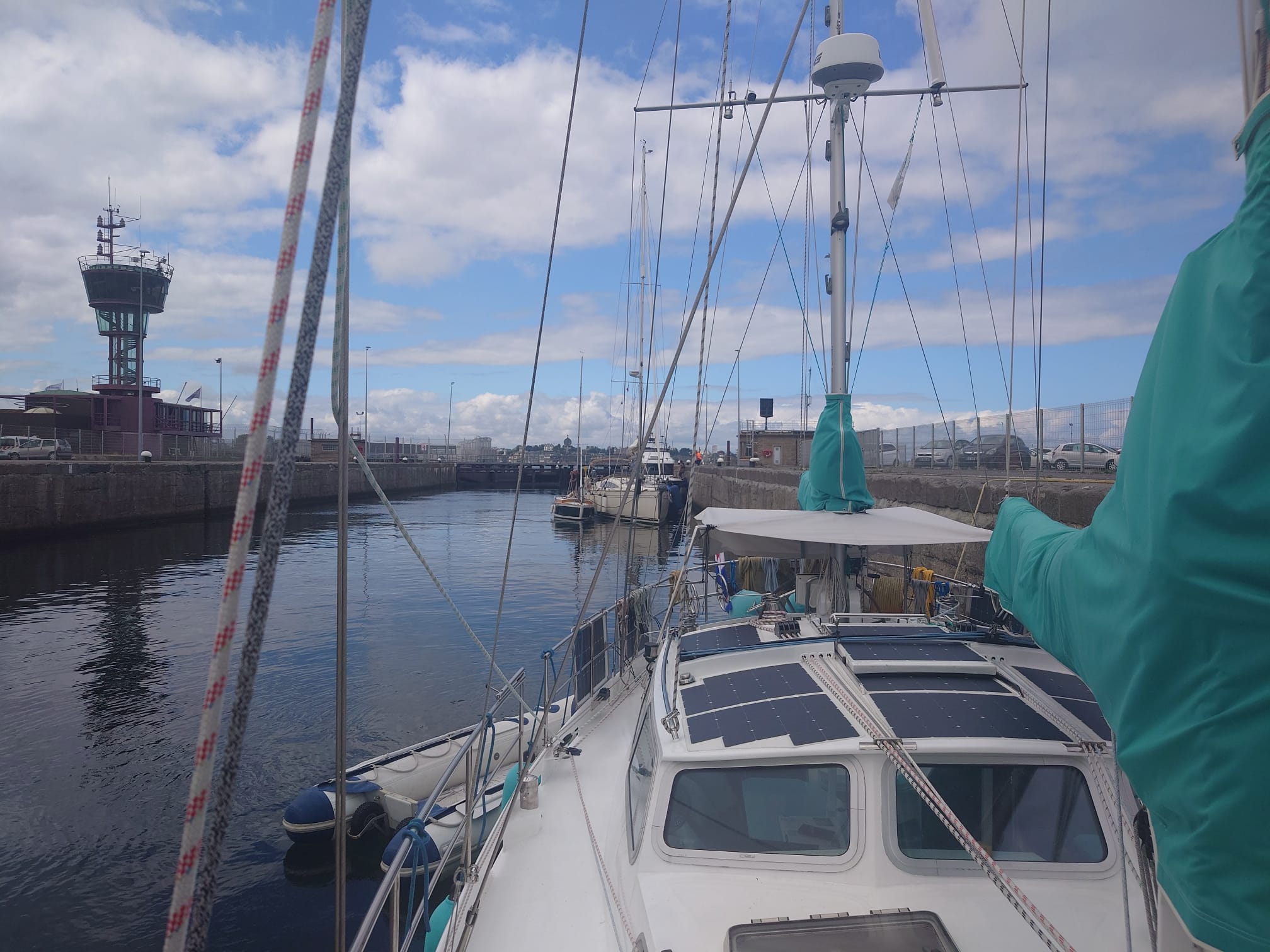
Then, we sail right into the historic heart of St. Malo.

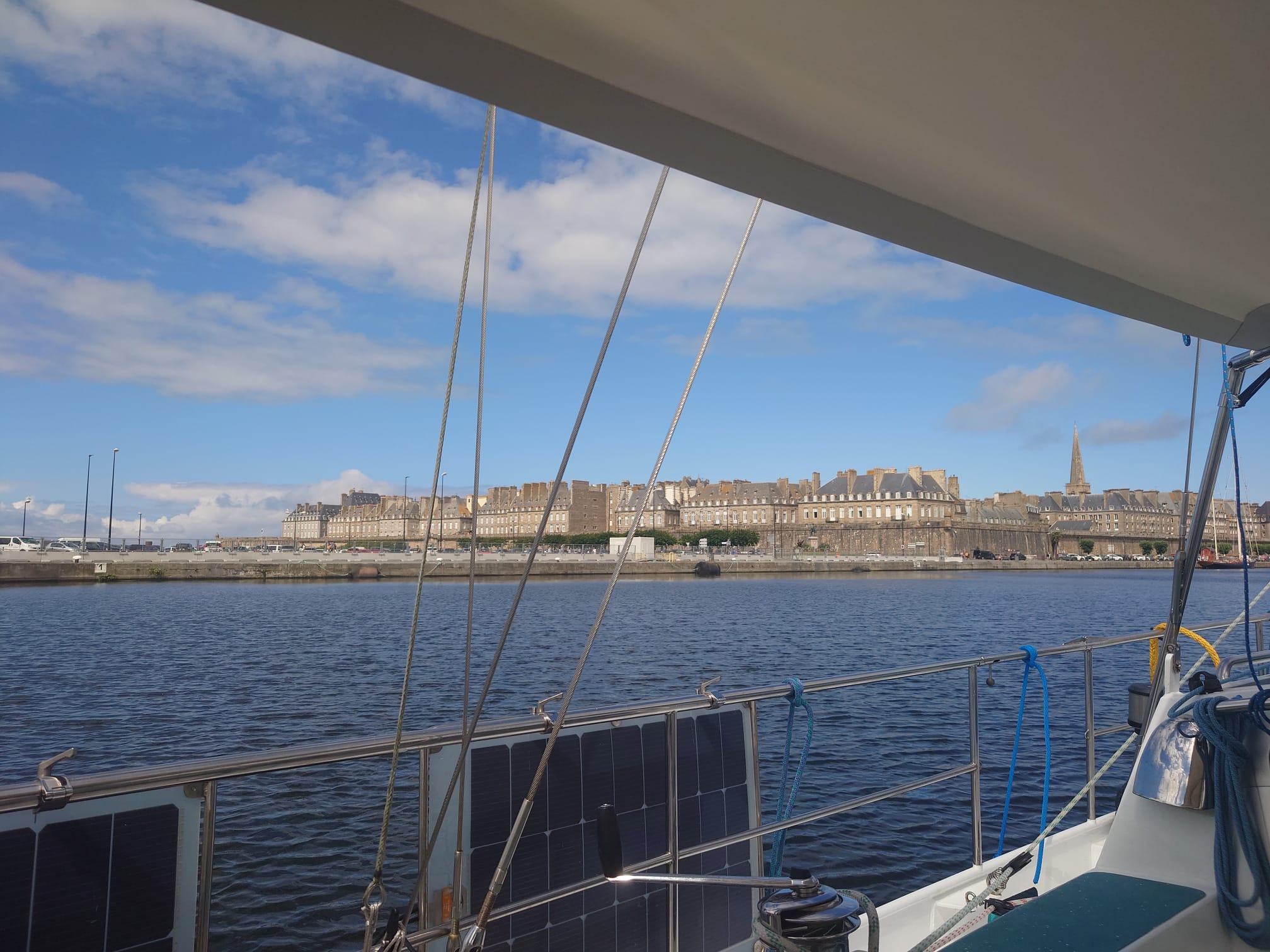
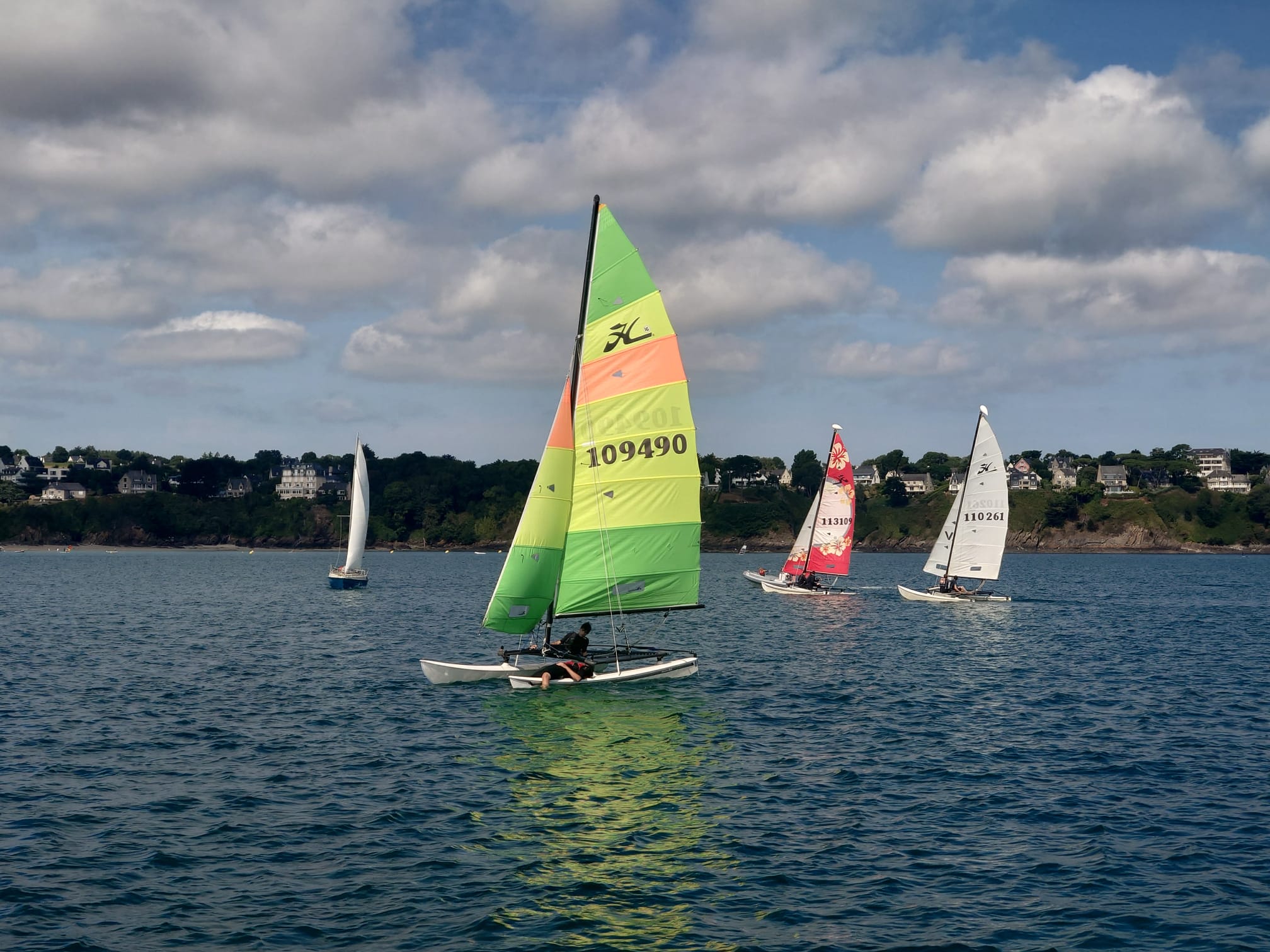
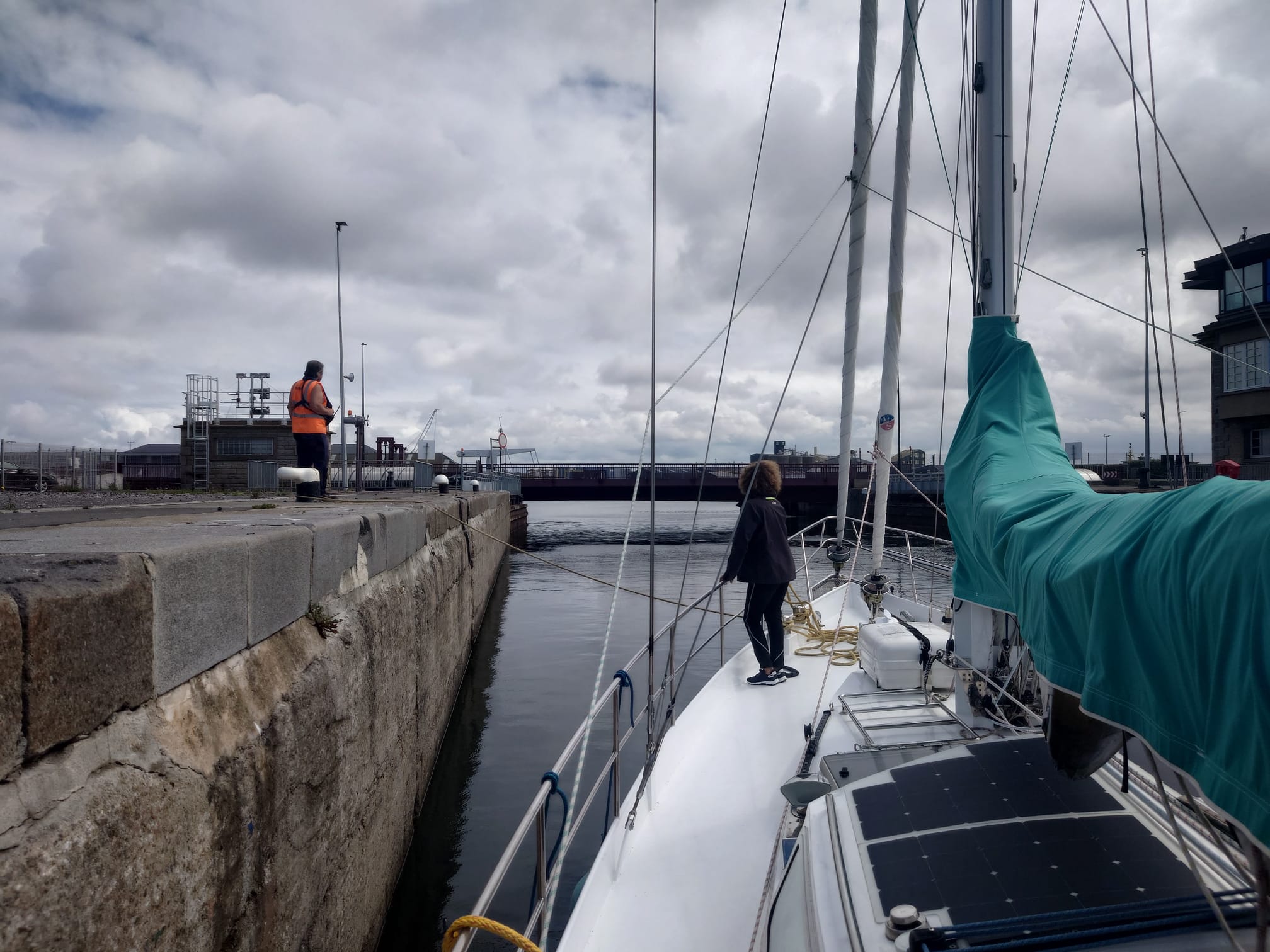
Leave a Reply